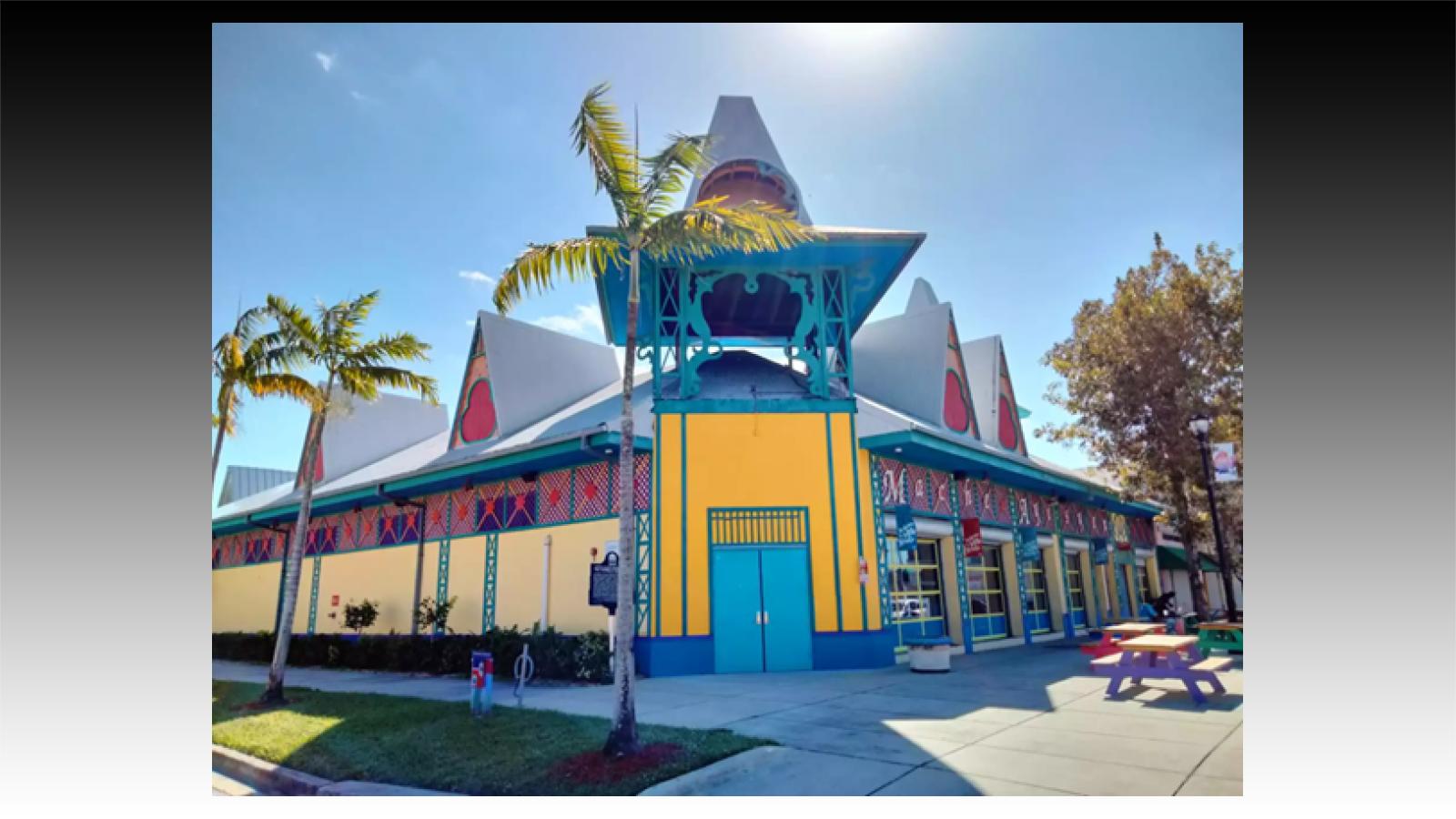Little Haiti Cultural Center hit with 'unsafe structures' violations. The community fears what comes next

The Little Haiti Cultural Center has been cited with two unsafe structures violations by the City of Miami, raising concerns that the cultural institution — often visited by presidents, top federal officials and touring musicians — could be shut down.
One of the violations: failing to obtain a 40-year recertification, as required by Miami-Dade law. The building is owned by the city, and in effect the city is citing itself for failure to follow the law.
The violations are dated January 29, mere weeks after a developer bought huge tracts of land in the surrounding area in a real estate foreclosure auction, raising community fears that mass development could transform the area into something unrecognizable.
City of Miami officials have not responded to WLRN requests for comment.
WLRN recently reported widespread concerns that the city is increasingly using unsafe structure violations to clear areas for more construction, an updated version of slum clearance strategies from the 1960s. Staff at the unsafe structures division of the city government has more than tripled since 2019.
Critics say the condo collapse in Surfside in 2021, which left 98 people dead, has made "unsafe structures" violations harder to argue against.
Sandy Dorsainvil was the manager of the Little Haiti Cultural Center off and on since 2013, until she was fired by city manager Art Noriega last year. At the time, she told the Miami Herald that the city does not seem to support the goal of the cultural center’s success. When she heard news of the unsafe structures violations, she felt partly vindicated — and alarmed.
“I just think it’s very odd that they fired me and didn’t replace me, and now it’s extremely understaffed, and barely has any programming,” said Dorsainvil. “And now there’s this random new person who just bought all these properties in the community — and now all of a sudden this building the city has owned for more than a decade is an unsafe structure? That’s too much of a coincidence.”
The city argued that Dorsainvil was insubordinate and that she signed off on an advertising contract to promote Haitian Heritage Month without prior approvals. Dorsainvil acknowledged that the city procedure was not properly followed, but said that only happened because the center was so short staffed.
On the City of Miami events calendar, planned events at the venue came to an abrupt halt after Doursainvil's ouster. The specific part of the cultural center that has been cited with unsafe structure violations is the Caribbean Marketplace, the area that holds weekly events for local vendors, along with offering Haitian food and music.
“It leads me to believe they have other plans for the structure. To sub-lease it, demolish it, to make it something other than what it is right now, which is a cultural institution,” she said.
History of issues
It would not be the first time the future of the site is in peril.
The marketplace building was designed by architect Charles Pawley and opened in 1990, costing $1.2 million to build. Former Haitian President Leslie Manigat was in attendance for the opening, alongside other Haitian officials and local elected leaders.
The building itself was meant to evoke the “Iron Market” of Port-Au-Prince, an open air bazaar built in the late 1800s.
Even before its opening, there were problems with the city government. The opening was delayed because of issues with getting the green light on electrical work and obtaining certificates of use for vendors. Shortly after, the building had trouble keeping up with shifting building codes in the aftermath of Hurricane Andrew. One consultant hired by the city complained in 2005 that the center had to spend “half our total budget” just to bring the building up to code.
The city of Miami took ownership of the building that year and planned to demolish it to the ground, until protests and pressure from local groups forced the city to save it.
Architect Pawley saw the original plan to demolish the building as having “no logical reason” other than the design not fitting into the city’s broader development plans.
“They want to put a building there that ties in to other buildings they are designing. This one is too strong, too Haitian-oriented and they don't want it on that corner,” Pawley argued a year before he died in 2006.
Gepsie Metellus, executive director of the Sant La Haitian Neighborhood Center, took part in the battle to save the marketplace from demolition in 2005. In recent years, she said, she has suspected that the city would like to sell the land, as concerns about “climate gentrification” of Little Haiti have taken hold.
The neighborhood occupies some of the highest ground in South Florida, and investors are increasingly seeing it as a safe place to invest and build, considering sea-level rise caused by global warming. As a result, Haitians and Haitian-Americans are being priced out.
Now all of a sudden this building the city has owned for more than a decade is an unsafe structure?
Sandy Dorsainvil, former manager of the Little Haiti Cultural Center
“These violations could be the opening shot” of eventually closing the center, Metellus warned.
The violations read, in part: “Failure to immediately comply this violation [sic] may result in the immediate evacuation of any person(s) occupying such structure.”
The notice is effectively the city talking to itself.
“I understand that because of safety concerns that unsafe structures are a priority,” Metellus said. “We get the safety concerns. But the city should hold a community meeting to tell us about those concerns and let the community weigh in, and be transparent so we can see how to preserve this property.”
One of the violations that the Caribbean Marketplace was hit with was over a failure to obtain a 40-year recertification, according to records obtained by WLRN. The county law mandating 40-year recertifications has increasingly been used after the 2021 Surfside condo collapse.
The main Caribbean Marketplace structure was built in 1989 and opened 33 years ago in 1990. However, the Miami-Dade Property Appraiser’s Office says that at least part of the structure was built in 1936, which would subject it to the law.
The property was first hit with a violation for not obtaining its 40-year recertification in April 2016, city records show. But the city never followed through to perform the recertification inspection on its own building.
Last month — nearly seven years later — two 40-year inspections showed that “corrections” were required on the building, including for structural elements. This prompted the city to issue the “unsafe structure” violations. The building passed an electrical inspection, according to the records.
City of Miami officials did not immediately respond on Friday to a WLRN request for comment about the timing of the violations or why it has not performed necessary work on its own building.
Many details surrounding unsafe structures in the city of Miami are shrouded in secrecy. Just this week, after inquiries by WLRN, did the city begin posting agenda meetings and minutes of Unsafe Structure Panel meetings. The documents contain photos and details about cases involving specific properties across the city. But agendas have only been posted going back to January of this year; past meeting agendas and minutes are still not publicly available.
'Like the epicenter of this whole area'
For Haitian immigrants, Pawley’s building has left a special imprint in the neighborhood.
“It’s like the epicenter of this whole area. It adds the true essence of Haiti. The structure, the colors, everything reminds you of home,” said Bilal Brooks, a Haitian native who has lived in Little Haiti since the aftermath of the 2010 earthquake.
Brooks sat on a picnic table in front of the building on a recent morning sketching new fashion designs.
“I don’t come here as often as I used to, but to me just seeing that building is knowing that I’m in Little Haiti,” he said.

Daniel Rivero/WLRN
Bilal Brooks is a Haitian native who has lived in Little Haiti since the aftermath of the 2010 earthquake. He says the Little Haiti Cultural Center is "like the epicenter of this whole area."
Only the city administration can fix various issues with the property, stressed former manager Dorsainvil, arguing the problems are far beyond a manager’s authority to address. For instance, she pointed to a change in city code that has made a lighting structure in the marketplace out of compliance with city standards.
“That should have been addressed through capital improvements part of the city. It has been years that we have been talking about this skylight,” she said.
The other part of the facility that was never addressed by the city was the fact that the city only gave the Little Haiti Cultural Center a temporary certificate of use, instead of a permanent certificate of use. This became an ongoing problem with the county when it came to registering tax documents for the small-scale vendors that use the marketplace space, said Dorsainvil.
That temporary certificate was allowed to expire by the city: One of the unsafe structures violations brought against the property by the city is for having an “expired temporary certificate.”
Over the years, the Little Haiti Cultural Center has been used as a stopover for visiting musicians, cultural figures, religious leaders and politicians.
In 2010, as vice president, Democrat Joe Biden visited the Little Haiti Cultural Center to discuss U.S. assistance after the devastating Haiti earthquake that left more than 200,000 dead. Later, in 2020, he visited it during his presidential campaign. For his part, in 2016, then-presidential candidate Donald Trump visited the Little Haiti Cultural Center during his campaign.
Earlier this month, Department of Homeland Security Secretary Alejandro Mayorkas was at the center to discuss a new immigrant visa program for Haitians, Cubans and Nicaraguans. It was his second visit to the center since 2021.
The unsafe structure violations placed on the building come as cultural and recreational locations in the city of Miami stare down a wave of simultaneous crises.
- The city owned Tower Theater, a longtime arts cinema that specializes in Spanish-language film, has been shut down after the city took over management from Miami-Dade College. The college had managed the facility for 20 years.
- In another controversial move, the city commission removed members from the Virginia Key Park Trust, angering Black residents who have long managed the site of the historical Black beach.
- The historic Coconut Grove Playhouse is facing an imminent partial demolition after a decade and a half of bureaucratic delays and court wrangling.
- The city owned James L. Knight Center on the Miami River, a longtime home for midsize musical acts and performances, will soon shut down after voters passed a referendum to turn the area into a billion dollar mixed-use development.
- The city-owned Miami Marine Stadium, closed since Hurricane Andrew in 1992, has seen redevelopment plans perpetually stalled; the parking lot is currently hosting a Magic Mike live show.
- Although it is owned by Miami-Dade County, the arena where the Miami Heat play, until recently called the FTX Arena, occupies central space in downtown Miami. The arena was caught up in what a federal prosecutor called “one of the biggest frauds in American history” and was forced to change its name.
photo : Daniel Rivero / WLRN
- Se connecter ou s'inscrire pour publier un commentaire
- 34 vues
Connexion utilisateur
Dans la même rubrique
Mustafa Benfodil ("El Watan.dz")
14/12/2025 - 10:42
Yves Tusseau
04/12/2025 - 11:09
Commentaires récents
Kamina Johnson, ministre des affaires étrangères jamaïcaines reçoit un don de 300.000 dollars de la Corée du Sud
CATASTROPHE NATURELLE
Albè
02/01/2026 - 19:53
Ce don fait suite à une catastrophe naturelle, en l'occurrence un cyclone. Lire la suite
Kamina Johnson, ministre des affaires étrangères jamaïcaines reçoit un don de 300.000 dollars de la Corée du Sud
Vous vous rendez compte de ce que vous écrivez ?
tim
02/01/2026 - 16:59
Que l'on veuille contrer la pathologie des Mqs /Gps pensant que l'absence de la Fce est un dang Lire la suite
Incapables de se battre pour obtenir la création d'un passeport martiniquais (ou guadeloupéen)...
PASSEPORTS CARIBEENS
Albè
31/12/2025 - 12:51
Antigue, Sainte-Lucie, la Dominique, Grenade etc... vendent leurs passeports. Lire la suite
Les négros-franchouillards admirateurs de "Charlie Hebdo" (et du "Canard Enchaîné") en deuil
"Tim", outre l'observation d'Albè, je vous ferai remarquer que.
Frédéric C.
30/12/2025 - 23:36
1)Rockaya DIALLO n'a rien à voir avec les terroristes-islamistes qui ont massacré sauvagement les Lire la suite
Les négros-franchouillards admirateurs de "Charlie Hebdo" (et du "Canard Enchaîné") en deuil
80.000 CIVILS MASSACRES A GAZA...
Albè
30/12/2025 - 19:31
...sans que cela n'émeuve PERSONNE en Occident ! Donc, arrête ton cinéma, mec :
Lire la suite
Top 5 des articles
Aujourd'hui :
- Mais amenez-les à la barre du tribunal, bon sang !
- Incapables de se battre pour obtenir la création d'un passeport martiniquais (ou guadeloupéen)...
- Kamina Johnson, ministre des affaires étrangères jamaïcaines reçoit un don de 300.000 dollars de la Corée du Sud
- COMMENT EXPLIQUER LES DESASTRES ELECTORAUX DES GAUCHES SUD-AMERICAINES ET DES CARAIBES
- Des chips de manioc nawflaw !
Depuis toujours :
- Tous les présidents et premiers ministres de la Caraïbe sont vaccinés
- L'intolérable appauvrissement intellectuel et culturel de la Guadeloupe et dans une moindre mesure de la Martinique !
- LETTRE OUVERTE AU 31ème PREFET FRANCAIS DE MARTINIQUE
- L'arrière-grand-père maternel de Joan Bardella était...algérien
- Les triplement vaccinés contre le covid ne bandent plus





